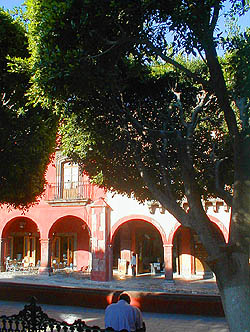The church and plaza of San Francisco are located 1 block east of the Plaza
Principal on the corner of the Via Juarez and the Via San Francisco. The plaza is
conceived as a garden with benches, walkways and a central fountain, framed by
geometric masses of ficus trees on 3 sides, with an opening on the south side,
opposite the south portal of the church. The rectangular and square-cut masses
of ficus trees frame the axis and the space of the garden, but they also create
a kind of negative space underneath out of shade.
The elaborate Churrigueresque portal panel of the south facade has deep triple
pilasters around a central arched portal with wooden doors, and a rectangular
window above. An statue of San Francisco de Assisi stands at the top of the
facade, below it is the crucifixion with Our Lady of Sorrows and San Juan on
either side. The tower has a 3 story pavilion and a small dome, the church also
has a dome over the crossing, the interior is mainly Neoclassical.
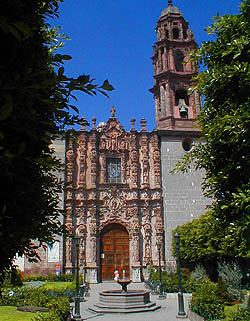
The Oratorio de San Felipe Neri is 2 blocks north and 1 block east of the Plaza Principal, and just west of the Plaza de la Soledad on a small triangular park at the corner of Insurgentes and Llamas. The church dates from the early 18th century, and features multiple domes, lanterns and towers in a mixture of Baroque style with native influences. The delicate lavender blossoms of the jacaranda tree in front of the church create a veil of color against the forms of the pink domes and lanterns. The triangular park along Insurgentes has a few round and square-cut ficus trees and some benches and planters in the middle of the space.
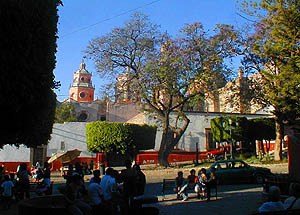
The church of San Felipe Neri is east of, or next to the Oratorio, with it's
south facade fronting on the western extension of the Plaza de la Soledad. The
facade has a central panel with double pilasters framing 5 niches with statues
of San Jose, San Juan Bautista, San Felipe, San Pedro and San Pablo. Above the
central arched portal there is a rectangular window topped by a sculpture niche
framed by quarter sections of a shell. The tower has a 3 story pavilion with a
small dome on top.
Inside the church there are 33 oil paintings of scenes from the life of San Felipe
Neri, the 16th century Florentine who founded the Oratorio order. In the east
transept there is a painting of the Virgin de Guadelupe by Miguel Cabrera. The
west transept has 2 pairs of twisted Baroque pillars at the entrance of the
Santa Casa de Loreto, a lavishly decorated chapel built in 1735, as a replica
of athe chapel in Loreto, Italy, legendary home of the Virgin Mary. The altar
has an image of the Virgin of Loreto in a glass case, and there are many other
altars in elaborate gilded Baroque.
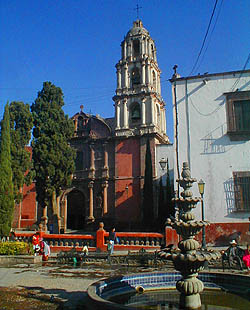
The streets of San Miguel are laid out in a simple rectangular grid emanating from the Plaza Principal in the center. Most of the buildings have 2 tall stories, and they are organized around interior courtyards behind the street facades. This view is looking south on the Calle Reloj just below the Plaza Principal, and into the arcades on the east side of the plaza, with the circular trees and the spire of the Parroquia church on the right. The deep red and yellow stucco of the facade made a complementary screen for the pink and beige stonework of the spire.
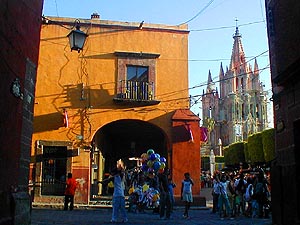
The Parroquia or parish church dominates the Plaza Principal, occupying most of the
block south of the space. It is an unusual structure with an overpowering spire above
the north portal, executed in eclectic Gothic pink and beige stone. It was designed
by an untutored native indian architect, Zeferino Gutierrez, in the late 19th century,
and he reputedly drew out the plans in the sand on the construction site with a stick,
much like the Gothic master builders did it in the medieval times.
The camarin, a chapel beside the main altar which contains ceremonial clothing for
images of saints, was designed by the neoclassical architect Eduardo Tresguerras in
about 1800. In the chapel to the left of the main altar there is a much-revered image
of Cristo de la Conquista, the Christ of the conquest, made by the natives of Patzcuaro
in neighboring Michoacan from cornstalks and orchid bulbs. The crypt contains the remains
of the 19th century Mexican president Anastasio Bustamante.
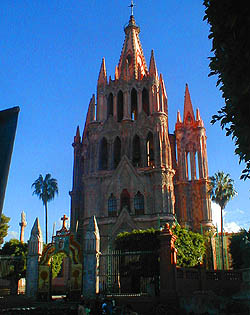
During the festivities of Semana Santa, the week before Easter, the many religious activities include a lavish procession of silence on Good Friday, and the burning of paper mache images of Judas Iscariot on Easter Day. Early in the day the paper dolls were displayed in the streets of the town, later they were assembled in front of the government palace and strung across the street to the plaza. Each figure represented a hated local politician, some of which were dressed in women's clothing, and they all had hoops of fireworks around their waists. In the afternoon the fireworks were lit, one by one, causing each figure to perform a wild and noisy , before exploding in a puff of smoke with a loud bang. Rarely have I witnessed anything more comical or deeply satisfying.
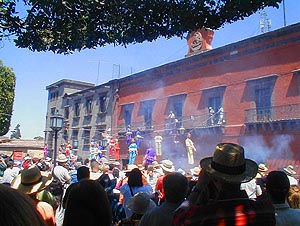
The Plaza Principal with it's circular ficus trees, concentric walkways and round-arched arcades was one of the finest public spaces I visited during my tour of the Bajio region of Mexico. The constantly changing views experienced during circumnambulation appeared often dream-like and hallucinogenic in their deep rich complementary colors and rythmic patterns and shapes, somewhat like being set in an Impressionistic painting by Monet or Renoir, or more particularly, in one of the rigidly idyllic landscapes of Seurat.
